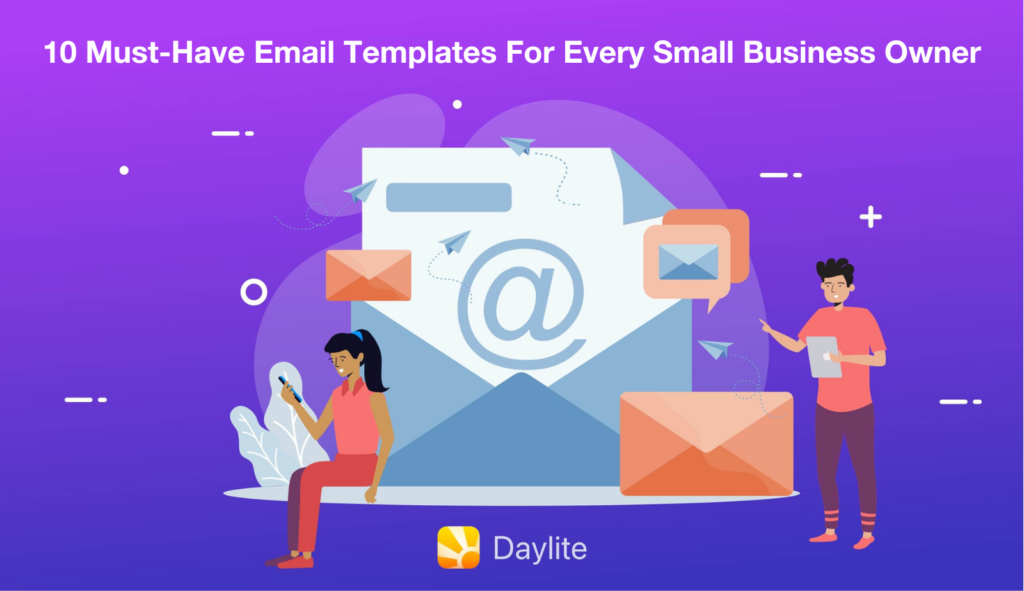Crafting compelling emails that resonate with your audience can make all the difference in building relationships, nurturing a brand reputation, and achieving growth as a result.
As a matter of fact, even in today’s fast-paced digital landscape, emails are making a surprising comeback, proving to be still an important tool for every small business owner striving to connect with clients, prospects, and partners.
But in the art of writing a well-crafted email that shows off the value of your business without being too pushy, you might find yourself staring at a blank screen, not knowing where to start.
That’s why we created this collection of the top 10 essential email templates you can leverage in your business’s daily operations. From captivating introductory emails that lay the foundation for strong connections to polished follow-ups that keep your audience engaged and even recovery emails that salvage potentially lost opportunities – we’ve got you covered.

10 Must-Have Email Templates for Small Business Owners
- Cold email template
- Follow up cold email template
- Following up after leaving a voicemail email template
- Following up after a final sales rejection email template
- Stay top of mind/checking in email template
- Following up to thank someone for a referral email template
- Following up with a “Thank You” for doing business email template
- Following up after a positive review email template
- Following up after a negative review email template
- Following up to make a correction email template
Pro tip: bookmark this blog so you can use it as a “cheat sheet” when sending an email.
1. Cold email template
Cold emails are a potent outbound marketing tool for small businesses seeking to expand their sales reach and drive growth. Not only do they provide an opportunity to introduce your products or services to potential clients who might not be aware of your services yet, but they also allow for personalized communication, showcasing how your business can address specific pain points of your audience.
Pro tip: The subject line is key when it comes to cold emails. Check out this blog we wrote specifically about writing engaging subject lines for your cold emails.
Template:
Email subject line: Do you have 5 minutes, [NAME]?
Hi [Name],
I’m reaching out because of your recent business expansion to New Jersey [meaningful connection].
My business, [your company name], specializes in providing [main services you offer] and has been helping people expand their businesses across the country [main benefit you offer], solving things like:
1. Navigating complex legal challenges when expanding operations to different states [pain point 1]
2. Protecting your interests during the expansion [pain point 2]
And more!
Can we schedule a quick call to go over how I can help?
Looking forward to hearing from you,
[Your name]
2. Follow up cold email template
If you sent a cold email and received no response after a few days, it might be time to send a follow-up email. That will help cut through the noise and ensure your message doesn’t get lost in the recipient’s inbox. In addition, following up also shows genuine interest and increases the likelihood of your efforts being noticed and considered.
Template:
Email subject line: Exploring financial strategies for your future [meaningful connection].
Hi [Name],
I just read about your recent business success [meaningful connection]. I’m reaching out again because I have [experience/expertise] in [industry]. My company specializes in [value statement about what you offer]. Here’s a [sample/link/another credibility example].
Should we get in touch soon?
Thanks,
[Your name]
3. Following up after leaving a voicemail email template
Voicemails can sometimes be missed or overlooked. Sending a follow-up email after leaving a voicemail is a strategic move that boosts your chances of getting your message across effectively.
The follow-up should provide a written summary of your key points, ensuring clarity and reducing any misunderstanding. This approach demonstrates your dedication to clear communication and consideration for the recipient’s convenience.
Pro tip: To avoid confusion, make sure that this follow up email is in line with the voicemail by addressing the same key points mentioned in the voice message. This will help get your message across as they will know that you’re the same person who sent the voicemail.
Template:
Email subject line: [Name], trying to get in touch with you.
Hi [Name],
I left you a voicemail earlier today to schedule a time to go over [your business].
I can’t wait to show you how we can help you find a commercial property [solve relevant pain point] that has everything you and your team need!
I mentioned I’d try calling again on [day/time], but you can email me at anytime if that works better. My email is [your email].
Looking forward to connecting with you!
Thanks,
[Your name]
4. Following up after a final sales rejection email template
Sending a follow-up email after a rejected business offer demonstrates a proactive and gracious approach that can leave a positive impression. While it’s natural to feel disappointed, maintaining a professional and cordial tone can keep the lines of communication open and potentially pave the way for future opportunities.
In this follow-up, make sure to express gratitude for the consideration regardless of the outcome and invite them to connect with your business on social media or other preferred channels. This will allow you to keep engaging and building a relationship with this potential client, even if they’re not doing business with you right away.
Template:
Email subject line: If you change your mind about working with [your business].
Hi [Name],
Thank you so much for letting me know and for considering [your business]. Your feedback was really helpful to me! I’m always available if you ever want to chat again in the future and the door is always open to working together!
I’d love to keep in touch and have you as part of my online network. My username is [your business account’s username] on [social media platform].
Keep in touch,
[Your name]
5. Stay top of mind/checking in email template
Sending emails to check in on individuals who are not your clients yet can be a highly effective strategy. These personalized check-ins demonstrate that you value their potential as clients and are willing to invest time and effort in understanding their needs. Such emails can also serve as a valuable touchpoint, keeping your business top of mind for when they are ready to make a purchase decision. In addition, by keeping up with potential clients and checking in regularly, you position yourself as a trusted advisor and industry expert, which will ensure that they reach out to you when they’re ready to close the deal.
Template:
Email subject line: This made me think of you
Hi [Name],
I came across this the other day and thought of you. I know you’re interested in starting your own business [relevant personal or professional interest], so this [resource] might be interesting!
How are things with [their business/hobby/interest] going? Please let me know if I could be of any help.
Keep in touch,
[Your name]
6. Following up to thank someone for a referral email template
Referrals are a testament to the trust and satisfaction that existing clients or contacts have in your business. Taking a moment to send a heartfelt thank-you email not only acknowledges their support but also strengthens the relationship. By acknowledging the value of referrals, you foster a positive client experience and increase the likelihood of receiving future recommendations.
Template:
Email subject line: Thank you for your referral
Hi [Name],
I wanted to thank you for referring [referral name] to [your business]. I truly appreciate you taking the time to connect us and help me grow my business.
We had a chance to connect and I look forward to working with [referral name].
Thanks again for the opportunity and let me know if you need my help with anything!
[Your name]
7. Following up with a “Thank You” for doing business email template
Sending “thank you” emails is a great and encouraged practice for small business owners. Not only do they leave a positive impression on clients, but also play a crucial role in cultivating relationships and fostering repeat business. These messages also serve as a way to collect feedback and request reviews, allowing for continuous improvement of your services and business growth.
Template:
Email subject line: So glad to have a client like you!
Hi [Name],
I was happy to help you with [pain point] and I just wanted to reach out and say thank you!
If you have a few moments, I would greatly appreciate if you could share your experience by leaving a review: [insert link]
Thank you once again for choosing [your business]. I hope to work with you again and stay in touch – it was really a pleasure working with you.
All the best,
[Your name]
8. Following up after a positive review email template
When a client leaves a positive review for your business, you may think your job is done. However, this extra step could be key in fostering a long-lasting connection between you and your clients, resulting in repeat business. Sending a follow-up email thanking them for the review is a way to show genuine gratitude for their business and acknowledge and celebrate their experience.
Template:
Email subject line: Your review made my day!
Hi [Name],
Thank you so much for taking the time to write [your business] an amazing review! I’m so grateful for the kind words you shared about [pain point you solved]. Making my clients happy is a huge priority, so hearing this from you truly made my day. I really hope to work with you again soon.
Thanks again,
[Your name]
9. Following up after a negative review email template
Reaching out to clients who have left negative reviews is crucial in effective customer relationship management. Addressing their concerns directly through an email demonstrates your commitment to understanding and resolving any issues they may have encountered.
By acknowledging their negative experience and offering a sincere apology, you showcase your responsiveness and dedication to customer satisfaction. It also allows you to learn from their feedback, implement necessary changes, and prevent similar issues in the future, contributing to your business’s overall growth and success.
Template:
Email subject line: I’m sorry about your recent experience
Hi [Name],
Thank you for taking the time to share your feedback about [your business]. I’m really sorry you had such a frustrating experience and it didn’t meet your expectations.
I really appreciate you bringing it to our attention. I’d love to have an opportunity to discuss your concerns and make things right for you.
Can we please schedule a call to chat?
Best regards,
[Your name]
10. Following up to make a correction email template
Mistakes can happen to anyone. We’re sure you can relate to this if you ever mistakenly sent an email without an attachment, the wrong date or time for a meeting, a broken link, etc. What will set you apart is promptly addressing the mistake in a correction email.
Acknowledging the error and providing accurate information not only rectifies the immediate issue but also contributes to a lasting positive impression and solidifies your reputation as a reliable and customer-centric business.
Template:
Email subject line: Oops! Corrected [information/date/link/etc.]
Hi [Name],
Sorry about that! My previous email included the wrong [information/link/date/etc.].
my mistake! Here’s the correct email:
[include corrected email in its entirety]
My apologies for the inconvenience,
[Your name]
Click here to go back to the template summary at the top of the page.
Wrapping Up
With these 10 must-have email templates at your fingertips, you’re equipped to navigate various scenarios and interactions with confidence. Whether it’s expressing gratitude, reaching out for partnerships, seeking referrals, or addressing concerns, these templates serve as valuable tools to streamline your communication efforts and improve your business operations.
Remember, personalization and authenticity are key to establishing meaningful connections, so adapt these templates to resonate with your unique brand and voice. As you continue to nurture relationships, solve problems, and drive growth through your email interactions, may these templates serve as a foundation for the success of your small business.
About the author: Thanny Schmitz is a seasoned copywriter and content strategist passionate about technology and entrepreneurship. With over a decade of experience, Thanny has been behind insightful articles and blogs that inform and spark meaningful conversations within the ever-evolving spheres of tech and small business success.


